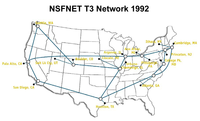
Photo from wikipedia
Optimal routing decisions are key in communication network environments to minimize bottlenecks such as traffic congestion and limited bandwidth. Routing in wireless mesh backbone networks is the focus of this… Click to show full abstract
Optimal routing decisions are key in communication network environments to minimize bottlenecks such as traffic congestion and limited bandwidth. Routing in wireless mesh backbone networks is the focus of this study given that they are popular particularly for providing broadband connectivity to a huge number of users accessing and transmitting multimedia data hence are susceptible to communication-oriented bottlenecks. Existing routing solutions are mainly optimistic approaches. These mainly depend on link states, distance and hop counts which present a routing generalization bottleneck especially in huge wireless mesh networks because it is difficult to get the entire footprint of the network. Simply put, it is very difficult to determine an optimal route in a huge wireless mesh network (WMN) with dynamic network conditions. Since deep learning has a strong generalization ability. In this paper, a deep learning-based routing approach is proposed with the goal of ensuring a defined optimal quality of service (QoS) in a WMN. In order to achieve the study purpose, a wireless mesh network simulation environment is built and a network data feature set is orchestrated to generate a data set used to train a Long short Term Memory (LSTM)-based deep learning model that estimates the route with the optimal QoS. The generated data set is validated by training other learning models including the Multilayer Perceptron (MLP), Logistic Regression (LR) and Random Forest (RF). Our results show that the routes selected by the LSTM-based model provides the best packet delivery ratio (PDR) and throughput. Our results further show that the learning models (MLP, LR, RF) also provide better PDR and throughput compared to the traditional Ad-hoc On-demand Distance Vector (AODV) routing protocol.
Journal Title: IEEE Access
Year Published: 2023
Link to full text (if available)
Share on Social Media: Sign Up to like & get
recommendations!